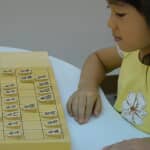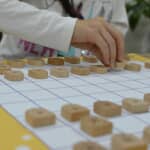Shogi 17 June 2019
Bible of Handicap Game –8 Pieces Dropped–
A series of articles named “Bible of Handicap Game” provides you a good knowledge of learning points and goals in several types of handicap games, Koma Ochi. This is the fourth article, which deals with a 8-piece handicap.
Koma Ochi refers to a handicap Shogi game. When players play a Koma Ochi game, a stronger player drops his/her own piece/pieces. The number of dropped pieces depends on the difference in skills. The bigger the difference is, the more pieces the player drops. Originally, Koma Ochi was introduced to make a game more fun eliminating the skills gap. Learning Koma Ochi is also very effective to understand Shogi.
Previous Related Articles:
Bible of Handicap Game –10 Pieces Dropped, without Fu (Pawn)–
Bible of Handicap Game –10 Pieces Dropped–
Bible of Handicap Game –9 Pieces Dropped–
Bible of Handicap Game –8 Pieces Dropped–
Today’s topic is a 8-piece handicap. The difference from the previous one, Bible of Handicap Game –9 Pieces Dropped–, is that an opponent’s Gyoku (King) has two pieces of Kin (Gold) on both sides. When 9 pieces have been dropped, Gyoku (King) has one piece of Kin (Gold) on either side. As I have told in the previous article, Kin (Gold) plays an important role as a Gyoku’s (King’s) bodyguard. Under this handicap, 8 pieces dropped, an opponent has two bodyguards. The same attacking way as a 9-piece handicap is not going to work well.
Goal to Be Achieved through Learning a 8-Piece Handicap
• Take aim at an opponent’s weak points
• Attack with the collaboration of major pieces and minor pieces

Aim at Opponent’s Weak Points
I do hope this series have helped children understand an important point to play a Shogi game. That is players should catch their opponents off guard to promote major pieces. There are two pieces of Kin (Gold) who are protecting Gyoku (King) firmly. Apparently, the piece formation of a 8-piece handicap game might look invulnerable. It’s not the case. What is the weak point of a 8-piece handicap situation? The answer is the files where only Fu (Pawn) is placed. In this situation, two files, the 1st and the 9th files, are to be good targets.
Let’s see practical situations.
First, following the theory, you move Fu (Pawn), P-7f, to make a path for Kaku (Bishop). If you keep following the theory, you may move Fu (Pawn) placed ahead of Hisha (Rook) and then exchange pieces of Fu (Pawn) as a preparation for Hisha (Rook) to break through an opponent’s camp. Things will go differently in this situation. I will describe the way to attack the 9th file using Kaku (Bishop).
If Kaku (Bishop) stays at its initial position, it’s not possible to aim at a square of 9c which is a weak point of your opponent. Accordingly, you need to move Kaku (Bishop) to the 6f square, from where Kaku (Bishop) can aim at a square of 3c and at the same time it can also aim at the 9c square.
By aiming at the 3c square, Kaku (Bishop) is going to prevent Kin (Gold), △G3b, from moving.

Now, I am going to tell you an important thing for the next steps. In the above situation, generally, you may move and promote another major piece, Hisha (Rook). But this time I would recommend to use an edge attack which is made on the edge file, the 9th file. Surely, you can follow the classic way to attack by pushing Fu (Pawn) ahead of Hisha (Rook). But using an edge attack is more efficient and I want you to experience it. When you use an edge attack, instead of Hisha (Rook), Kyosha (Lance) on the 9th file will be a Kaku‘s (Bishop’s) partner.
After you move Kaku (Bishop) to a 6f square as a preparation for Kaku’s (Bishop’s) promotion, you move Fu (Pawn) ahead of Kyosha (Lance), ▲P-9f, ▲P-9e, and ▲P-9d. Then your opponent will take the Fu (Pawn) with his/her Fu (Pawn), △P-9d, and you will take the Fu (Pawn) with Kyo (Lance), ▲L-9d. When you reach this point, it’s impossible for your opponent to protect the square of 9c. Promoting Kyo (Lance) and Kaku (Bishop), you complete an edge attack successfully.

Have Close Coordination between Major Pieces and Minor Pieces to Attack
Having a reassuring attacker, Nari-Kyo (Promoted Lance), within an opponent’s camp, it’s time for your Hisha (Rook) to work. You may move Fu (Pawn) ahead of Hisha (Rook) and then aim to break through the camp. That is one possible way, but now we will attend to attacks from the 9th file, which is more efficient way.
First, you move Hisha (Rook) to the 9th file and move to promote it along the file.
During a lesson, I often ask children, “There is a piece that hasn’t been working. What is it?” Mostly, they show confusions a little while and then answer, “It’s Hisha (Rook)”. There are other pieces that also haven’t been working. Kyo (Lance) and Kei (Knight) on the right side stay at their initial positions. Unlike those pieces, Hisha (Rook) is supposed to work for attacking. It is a waste not to move Hisha (Rook). Let’s move Hisha (Rook) widely to the 9th square and promote it at the 9c, +R-9c. You will have Ryu (Promoted Rook) there!

Now, let’s move on the most important point to play a 8-piece handicap game.
As I told you earlier, it is difficult to take an opponent’s Gyoku (King) just with Uma (Promoted Bishop) and Ryu (Promoted Rook). The reason for this is because you need to remove defensive two Kin (Gold) pieces that are well connected to Gyoku (King). You took time to move Kyo (Lance) and promoted it, Nari-Kyo (Promoted Lance). All efforts will pay off, because Nari-Kyo (Promoted Lance) plays a role of removing defensive pieces.
Using the above picture, I am going to explain how to remove the opponent’s Kin (Gold). First, move Nari-Kyo (Promoted Lance) toward the opponent’s Kin (Gold). You might say, “Hang on! I won’t do that, because the Kin (Gold) will take my piece.” If you thought so, I would recommend reviewing our previous lessons: “The Point That Shogi Beginner Children Might Get Confused: 1. Piece Value” and “The Point That Shogi Beginner Children Might Get Confused: 2. Piece Change“.
Once your Nari-Kyo (Promoted Lance) approaches to the 6c square, the Kin (Gold) won’t be able to escape and you will succeed in removing the Kin (Gold), △Gx6c ▲+Rx6c.

What you need to do after promoting minor pieces such as Fu (Pawn), Kyo (Lance), and Kei (Knight) is to let them work in collaboration with promoted major pieces, Ryu (Promoted Rook) and Uma (Promoted Bishop).
This issue is dealt in one of our Shogi books, Shogi Lesson Book for Beginners Vol. 4, Day 99. It’s useful offensive mindset you exchange your pieces aggressively with an opponent’s Kin (Gold) and Gin (Silver), and focus on removing his/her Kin (Gold) and Gin (Silver).
Build Up Skills
Promote Your Fu (Pawn) and Have To-Kin (Promoted Pawn)

The above picture shows the situation of a 8-piece handicap game played on a TV show by Nakamura Ouza and a students of i-tsu-tsu Shogi class. The highlight here is Fu (Pawn) on the 2d square. This piece was not placed initially but dropped on the second file with an aim to promote it.
It is called “Tare Fu“, a dangling Fu (Pawn), to drop a hand piece of Fu (Pawn) on the third or the fourth ranks with an aim to make a promoted piece.
From an opponent’s point of view, your To-Kin (Promoted Pawn) is a troublesome piece. It moves just like Kin (Gold) and returns to Fu (Pawn) when he/she takes it. Implying this feature, there are a couple of Shogi provers. One of them is “Mamushi no To-Kin“.
When players play a handicap game, a weaker player has more pieces of Fu (Pawn) than a stronger player. That’s why Shogi beginners should learn the effective way to use Fu (Pawn) and knowing the way is going to be one of important keys to achieve a goal of 8-piece handicap game.
Prevent Opponent from Having To-Kin (Promoted Pawn)
As I mentioned above, your opponent wouldn’t be happy about you promoting Fu (Pawn) and having To-Kin (Promoted Pawn). So are you! When your opponent drops his/her Fu (Pawn) on the third or fourth rank, consider the situation as a dangerous one and do something against to the dropping.
Let’s wrap up this article.
There are many things that you need to be careful when you play a 8-piece handicap game. You need to take an additional step to threaten your opponent’s camp with major pieces’ reaching power.
In addition to that, you need to have another attacker besides Ryu (Promoted Rook) and Uma (Promoted Bishop).
You can’t expect all player will play following what you have learned in this article.
Even though your opponent plays differently from what you have known, the important points you learned can be applied in all situations. The knowledge you learned here will help you to play a game without a handicap as well.
I’ve experienced many students of my classes gradually get to win a 8-piece handicap game after learning the basic theory of a 8-piece handicap.
Practice is the key, as you know!



